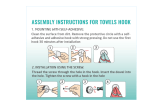
INSTALLATION INSTRUCTIONS
for Vinyl Patio Doors with Integral Nailing Fin (JII006)
2
PROVIDED MATERIALS
4 - #10 x 2 1/2" screws (to secure the strike plate)
NEEDED MATERIALS
Note! Follow all material manufacturers’ instructions for proper use
and compatibility. When using ashing, spray adhesive/primer, sealant
and foam products, we recommend using the same manufacturer and
verifying compatibility. It is the End User's responsibility to determine if
dissimilar materials are compatible to the substrates in the application.
• 1 3/4" galvanized roong nails or #8 x 1 1/4" pan head or washer
head (stainless steel recommended) screws. Fasteners must penetrate
at least 1" into framing (or as required by local code).
• Non-compressible or water degradable shims.
• Sill pan: It is best practice to use a pre-formed, rigid, positively
sloped, pvc pan that provides continuous support. We recommend
using SureSill
™
Sloped Sill Pan
™
, manufactured by SureSill
™
, Ltd. An
alternative would be a non-sloped pre-formed sill pan or one that
can be fabricated on site from metal or vinyl sheet material with the
proper tools.
• Sealant: We recommend OSI
®
QUAD
®
Max Sealant or equivalent. This
can be used in any application and can be painted or ordered in a
color matched product, if desired.
• Backer rod 1/8" larger than the widest portion of the gap (used in
conjunction with sealant bead).
• Polyurethane low expansion Window and Door foam: We recommend
OSI
®
QUAD
®
Foam or equivalent).
• 4", 6", or 9" (as required by local code and window conguration)
wide self-adhesive ashing: We recommend OSI
®
Butyl Flash Tape
orequivalent.
• Spray adhesive/primer for self adhesive ashing. Such as Loctite
®
300
or equivalent.
• For step-down landings only: Plastic drain screen with crisscross or
woven pattern (sold in 6" widths to protect rain gutters) and 3/8"
staples. The drain screen provides a path for air to dry any incidental
moisture in the rough opening.
• Drip cap material, if not supplied, required only for side-by-side
mulled units that extends the length of the frame plus 1/8" overhang
on each end.
NEEDED TOOLS
• Hacksaw (used only for SureSill
sill pan)
• Cutting shears (used only for
fabricated sill pan)
• Tape measure
• Utility knife
• Level (4 ft. minimum
recommended)
• J-roller
• Caulking gun
• Drill with bits
• Construction stapler
SAFETY
• Read and fully understand ALL manufacturers’ instructions before
beginning. Failure to follow proper installation instructions
may result in the denial of warranty claims for operational or
performanceproblems.
• Do not work alone. Two or more people are required. Use safe
lifting techniques.
• Use caution when handling glass. Broken or cracked glass can cause
serious injury.
• Wear protective gear (e.g. safety glasses, gloves, ear protection, etc.).
• Operate hand/power tools safely and follow manufacturer’s
operating instructions.
• Use caution when working at elevated heights.
• If disturbing existing paint, take proper precautions if lead paint is
suspected (commonly used before 1979). Your regional EPA
(www.epa.gov/lead) or Consumer Product Safety Commission ofces
provide information regarding regulations and lead protection.
MATERIALS AND PATIO DOOR HANDLING
• Make sure the operating panel is secured prior to installation.
• Heed material manufacturers’ handling and application instructions.
• Protect adhesive surfaces from dirt, moisture, direct sunlight and
folding over onto themselves.
• Handle in vertical position; do not drag.
• Do not put stress on joints, corners or frames.
• Store patio door in dry, well-ventilated area in vertical, leaning
position to allow air circulation; do not stack horizontally.
• Protect from exposure to direct sunlight during storage.
• Install only into vertical walls and when conditions and sheathing
are dry.
• Only use recommended sealants on vinyl products.
IF INJURY OCCURS, IMMEDIATELY SEEK MEDICAL ATTENTION!
OPEN-STUD CONSTRUCTION
If self-adhesive ashing
is to be applied so that
it is wider than the
framing of the wall,
it may be necessary
to cover the wall
with backing support
sufcient to support
the entire width of the
ashing.
This backing support
should be a non water-
degradable, thin (max. 1/8" thick) sheet material such as vinyl sheeting.
Completely surround the rough opening with the backing support as
shown. Backing support must be applied before building wrap.
This installation guide specically addresses sheathed wall and
open-stud construction.
FULLY SHEATHED WALL CONSTRUCTION
The wall framing is
covered by sheathing.
This installation
assumes building wrap
is properly installed
over the sheathing
and the door will
be mounted with
the nailing n ush
against the sheathing.
Open-Stud
with Backing
Sheathed
Wall
Trimmer
studs
Header
Building
wrap
Sheathing
Sill area
King
stud
ROUGH OPENINGS
SAFETY AND HANDLING
MATERIALS AND TOOLS










